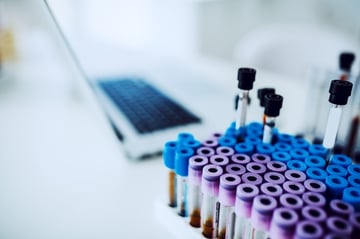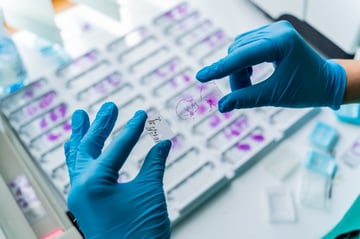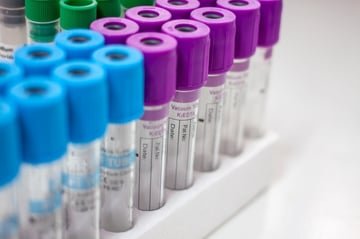
Bioanalytical Services
Assessing your Drug-Drug Interaction Testing Risk
Determine any drug-drug interaction liability for your new drug/molecule
During development of new chemical entities (NCEs), an investigation into the likelihood of drug-drug interactions (DDI) is vital to the progression of these drug candidates. Possible drug-drug interactions can alter the pharmacokinetics of concomitantly administered medications, altering efficacy or toxicity. Drug-drug interaction testing provides a definitive assessment of these risks and should be performed early after selection of a lead candidate. As part of IQVIA Laboratories suite of ADME services, our scientists routinely evaluate these risks through validated, in vitro assays to determine the cytochrome P450 enzymes responsible for metabolism of NCEs and to assess the potential for NCEs to inhibit and/or induce these enzymes. These data will be included in the filing of the Investigational New Drug (IND) application to provide guideposts for clinical DDI assessments during the further development of drug candidates.
In Vitro IND-Enabling DDI Assays
Inhibition of Cytochrome P450 (CYP) Enzymes
- Assess the potential of test article to inhibit the main cytochrome P450 isoforms: CYP1A2, CYP2B6, CYP2C8, CYP2C9, CYP2C19, CYP2D6, and CYP3A4 (up to 3 probe substrates)
- Test article is incubated with pooled human liver microsomes (HLM) and NADPH in the presence of a cytochrome P450 isoform-specific probe substrate (~Km)
- Optional assessment of time-dependent inhibition (TDI) following pre-incubation of 30 minutes
- Sample analysis and quantitation by validated and optimized LC-MS/MS methods
- IC50 values are generated to assess reversible inhibition and signals for TDI (IC50 shift ≥ 1.5)
- If inhibition observed for any CYP enzyme, further kinetic analysis can be performed to determine the Ki value and type of reversible inhibition observed (competitive, etc.)
- Full QC reviewed, regulatory style report
Time-dependent Inhibition of CYP Enzymes
- Determine the kinetics of time-dependent inhibition of the main CYP isoforms: CYP1A2, CYP2B6, CYP2C8, CYP2C9, CYP2C19, CYP2D6, and CYP3A4
- Test article is incubated with pooled human liver microsomes (HLM) and NADPH for various time points for inactivation phase before dilution into the activity assay mixture containing a cytochrome P450 isoform-specific probe substrate
- Sample analysis and quantitation by validated and optimized LC-MS/MS methods
- The percent remaining enzyme activity at each inactivation timepoint will be determined for each inhibitor concentration (kobs rate determination) and used to calculate the kinetic parameters (KI and kinact) using nonlinear regression
- Full QC reviewed, regulatory style report

Induction of CYP Enzymes
- Assess the potential of test article to induce CYP1A2, CYP2B6, and CYP3A4 through mRNA analysis and/or enzymatic activity
- Pretests to inform top concentration of test article include assessment of solubility in incubation media and cytotoxicity in a single lot of hepatocytes
- Test article is incubated with plated cryopreserved human hepatocytes pre-characterized to be responsive to CYP1A2, CYP2B6, and CYP3A4 induction before analysis of mRNA levels and/or addition of probe substrate(s) to assess enzymatic activity
- Optional determination of the induction of CYP2C8, CYP2C9, and CYP2C19 is available
- Fold-induction over vehicle control is calculated. EC50 and Emax values to be calculated if induction is concentration-dependent and >2-fold at max
- Full QC reviewed, regulatory style report

CYP Reaction Phenotyping
- Determine the CYP enzymes involved in the metabolism of a test article using two complementary assay designs
- Evaluating the percent contribution of each of 7 CYP enzymes in the metabolism of the test article by sequentially inhibiting CYP activity
- Test article is incubated with HLM and NADPH in the absence and presence of selective CYP-specific inhibitors
- Fraction metabolized by each CYP enzyme will be calculated (fm,CYP)
- Evaluating the percent contribution of CYP enzymes in the metabolism of the test article using recombinantly expressed CYP enzymes
- Individual CYP relative activity factors (RAF) will be used to estimate fraction metabolized by each CYP enzyme
- Full QC reviewed, regulatory style report

In Vivo DDI Study Support
At IQVIA Laboratories, we specialize in delivering high-quality bioanalytical support for in vivo drug-drug interaction (DDI) studies, with a proven track record of managing the complex logistics these studies demand. We offer a full list of non-proprietary assays (see full list here) to support your in vivo DDI studies.
Expertise in Complex DDI Study Logistics
Our team brings decades of experience navigating the intricacies of DDI study design and execution. From coordinating multi-arm crossover studies to managing time-sensitive sample collection and shipment schedules, we ensure seamless integration with clinical operations. Our project managers and scientific leads work closely with sponsors to anticipate challenges and implement proactive solutions—keeping your study on track and on time.
Extensive Laboratory Capacity
With a robust infrastructure and scalable resources, our lab is equipped to handle high-throughput sample analysis without compromising turnaround time. Our state-of-the-art LC-MS/MS platforms, automated sample preparation systems, and dedicated DDI study teams allow us to support studies of any size or complexity—from early-phase investigations to pivotal regulatory submissions.
Uncompromising Quality
Quality is at the core of everything we do. Our validated methods, rigorous quality control processes, and adherence to global regulatory standards ensure that your data is accurate, reproducible, and audit-ready. We pride ourselves on delivering results you can trust, with transparency and scientific integrity.
Related Services

ADME / DMPK Services
Learn more
Early Hit-to-Lead ADME Screening Bundle
Learn more
In Vitro Screening
Learn more
Discovery Bioanalysis
Learn more
High-Throughput ADME Services
Learn more
In Vitro Metabolism
Learn more
Assessing your Drug-Drug Interaction Testing Risk
Learn more
ADME Assays & Metabolite Profiling and Identification Services
Learn more
Metabolite Identification and Profiling
Learn more
Bioanalytical Services
Learn more
Small and Large Molecule LC-MS
Learn moreRelated Insights

ADME Services
Accelerating your drug discovery, preclinical and clinical programs
Developing Assays for Novel Drugs
Current science regarding hybrid assays, why they are considered the next "big thing," the technical challenges, and the regulatory impact of these assays.

Hybrid Assays for Protein Bioanalysis
Assays and Why Are They Essential for Protein Bioanalysis?

Bioanalysis for Immuno Oncology with Mike Brown
I-O clinical development podcast series
High Throughput ADME Testing
Minimizing turnaround time for ADME assays
ADME Services
Accelerating your drug discovery, preclinical and clinical programs with ADME services
Assay Development for Large-Scale Clinical Studies
Bioanalytical expertise to support large-scale, international studies
Early Hit-to-Lead ADME Screening Bundle
Bundled Screening Assays to Accelerate Candidate Selection in Drug Discovery
High Throughput ADME Screening Services
Capabilities that accelerate preclinical studies
IND-Enabling Bundle of In Vitro Assays to Assess Drug-Drug Interaction Risk
DDI Fact Sheet

